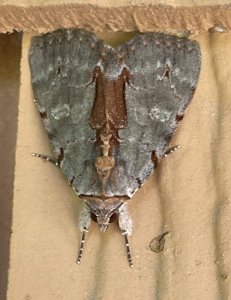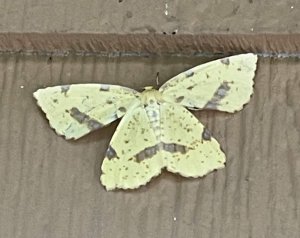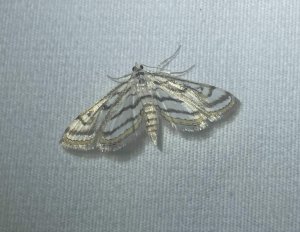Shining a Light on Nighttime Pollinators
October 16, 2024
By: Alexis Olechowski, Park Interpreter
Moths are often overlooked as pollinators, yet they play a crucial role in sustaining ecosystems, especially as nocturnal pollinators. While bees and butterflies are the stars of the day, moths take over at night, visiting a wide variety of flowers and transferring pollen as they feed on nectar. This makes them vital for plants that bloom or release their fragrance after dark, such as evening primrose, jasmine, and honeysuckle. Some moths are even specialized to pollinate nocturnal blooms like orchids. Let’s shine a light on some of the major ways moths play a role in our ecosystems.

For years, pollinator research has focused primarily on daytime species like bees and butterflies, often overshadowing the contributions of less-recognized pollinators like moths. However, recent studies from University College London have highlighted the important role moths play. These studies suggest that moths may rival bees and butterflies in their pollination effectiveness, given the large amounts of pollen they carry on their hairy bodies and their willingness to travel greater distances between flowers.
Much like butterflies, moths use long tongues to sip nectar, pollinating flowers with every visit. However, moths have an advantage as they often rest on flowers while feeding, which allows their furry bodies—especially their ventral thorax—to gather and transfer more pollen as they move from plant to plant.
Moths interact with an impressive range of plants, many of which are overlooked by daytime pollinators. While bees and butterflies tend to favor bright, colorful flowers, moths work the night shift, focusing on pale or white blooms that stand out in the moonlight. They also rely heavily on scent, visiting flowers with stronger nighttime fragrances like creeping buttercup and honeysuckle. Moths are also skilled at pollinating flowers with deeply hidden nectar, such as morning glory, tobacco, yucca, and gardenia. In fact, they can pollinate up to 47 different plant species, surpassing bees and butterflies in variety. By complementing daytime pollinators, moths help maintain diverse and abundant plant populations, serving as a natural backup that enhances ecosystem resilience.

In agriculture, moths are key players, pollinating crops that bloom at night or in low-light conditions. Their ability to reach plants that daytime pollinators overlook acts as a safeguard for crop yields. Protecting moths from light pollution is crucial to preserving pollinator diversity, which is essential for stable, resilient food systems, reducing the risk of crop failure, and supporting sustainable farming practices.
Unfortunately, global pollinator populations are in decline due to factors like monocropping, pesticide use, and climate change. Moths are no exception, and their decline underscores the urgent need to include them in conservation efforts.
Along with habitat loss and pesticides, moths are particularly vulnerable to light pollution. Artificial lighting—such as streetlights, billboards, and outdoor fixtures—drastically alters the nighttime environment. This disrupts moths in several critical ways:
- Disrupted Navigation: Moths are naturally drawn to light, a behavior known as positive phototaxis. In the wild, they use celestial light sources like the moon and stars to navigate. However, artificial lights disorient them, causing them to fly in circles or become “trapped” by light sources, distracting them from essential activities such as feeding, reproducing, and pollinating.
- Increased Predation: Artificial lights make moths more visible to predators like bats, birds, and spiders. When moths gather around bright lights, they become easy prey, leading to population declines and reduced pollination.
- Interrupted Reproductive Cycles: Moths rely on the cover of darkness to find mates using pheromones. Artificial light interferes with these signals, making it harder for moths to locate mates and successfully reproduce.
- Energy Depletion: Moths expend energy flying toward and around artificial lights, often without feeding. This wasted energy weakens them, reducing their ability to survive and pollinate, while also making them more susceptible to disease and predators.
- Displacement from Natural Habitats: In areas with high levels of light pollution, moths may avoid their natural habitats altogether, disrupting their interactions with nocturnal plants and leaving those plants without adequate pollination.

A chestnut-marked pondweed moth is attracted to lights on a building at night. Artificial light can cause harm to night-adapted animals like bats, moths, and owls.
The decline in moth populations due to light pollution has ripple effects on entire ecosystems. Moths are not only key pollinators but also serve as an important food source for various animals, including bats, birds, and small mammals. A reduction in moth numbers can impact these species, leading to decreased biodiversity. Additionally, plants that rely on moths for pollination may experience reduced reproduction, affecting the availability of seeds and fruits for other wildlife. Over time, this can shift plant community composition and further disrupt local ecosystems.
To protect moth populations and their role as nighttime pollinators, we can take steps to reduce light pollution:
- Install motion sensors and timers to minimize unnecessary lighting at night.
- Use shielded outdoor lights to direct light downward, reducing the spread of artificial light into the sky.
- Switch to warm-colored, low-intensity lighting, which is less attractive and disruptive to moths compared to bright, blue-hued lights. Moths and other insects see in UVB and cant see red light spectrum as well.
- Create dark-sky preserves, where artificial lighting is minimized to support nocturnal wildlife and maintain natural nighttime environments. This can include adding plants to your garden for moths. (See also planting for pollinators)
By reducing light pollution, we play a key role in helping moths thrive as essential nocturnal pollinators. Moths significantly impact both natural ecosystems and agriculture, as their survival directly influences plant reproduction, biodiversity, and food security. Minimizing artificial light allows moths to navigate, feed, and reproduce without disruption, ensuring that plants reliant on their pollination—especially those that bloom at night or have adapted to moths—can thrive. Creating environments that support moth populations strengthens both ecological and agricultural systems, promoting a more resilient future where plant diversity and essential ecosystem services like pollination are preserved.
